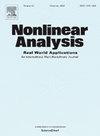Limit cycles of a class of hybrid piecewise differential systems with a discontinuity line of L shape
IF 1.8
3区 数学
Q1 MATHEMATICS, APPLIED
引用次数: 0
Abstract
In this work we study a class of discontinuous hybrid piecewise differential systems formed by two Hamiltonian systems that we named piecewise hybrid Hamiltonian systems. More precisely, we consider the differential systems with Hamiltonian functions with reset maps on and on for , and , are either zero, or one of them is a nonzero homogeneous polynomial of degree 3, and is the closure of .
We provide an upper bound for the maximum number of limit cycles that these hybrid piecewise differential systems can exhibit. In other words, we solve the extension of the 16th Hilbert problem to this class of hybrid differential systems.
一类具有L形不连续线的混合分段微分系统的极限环
本文研究了一类由两个哈密顿系统组成的不连续混合分段微分系统,我们称之为分段混合哈密顿系统。更准确地说,我们考虑具有哈密顿函数H1(x,y)=a1x+a2y+a3x2+a4xy+a5y2+A的微分系统,如果(x,y)∈Σ+H2(x,y)=b1x+b2y+b3x2+b4xy+b5y2+B,如果(x,y)∈Σ−具有复位映射R1(x)=sx在x≥0,R2(y)=ry在y≥0,对于0<;r,s<;1和A, B为零,或者其中一个是3次的非零齐次多项式,Σ+={(x,y)∈R2:x≥0andy≥0},Σ−是R2∈Σ+的闭包。我们给出了这些混合分段微分系统所能表现出的最大极限环数的上界。换句话说,我们解决了第16阶希尔伯特问题对这类混合微分系统的推广。
本文章由计算机程序翻译,如有差异,请以英文原文为准。
求助全文
约1分钟内获得全文
求助全文
来源期刊
CiteScore
3.80
自引率
5.00%
发文量
176
审稿时长
59 days
期刊介绍:
Nonlinear Analysis: Real World Applications welcomes all research articles of the highest quality with special emphasis on applying techniques of nonlinear analysis to model and to treat nonlinear phenomena with which nature confronts us. Coverage of applications includes any branch of science and technology such as solid and fluid mechanics, material science, mathematical biology and chemistry, control theory, and inverse problems.
The aim of Nonlinear Analysis: Real World Applications is to publish articles which are predominantly devoted to employing methods and techniques from analysis, including partial differential equations, functional analysis, dynamical systems and evolution equations, calculus of variations, and bifurcations theory.

 求助内容:
求助内容: 应助结果提醒方式:
应助结果提醒方式:


